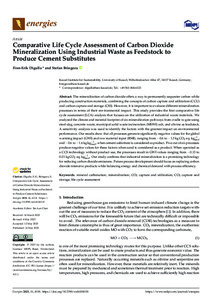| dc.date.accessioned | 2023-05-25T14:25:19Z | |
| dc.date.available | 2023-05-25T14:25:19Z | |
| dc.date.issued | 2023-05-16 | |
| dc.identifier | doi:10.17170/kobra-202305258114 | ger |
| dc.identifier.uri | http://hdl.handle.net/123456789/14762 | |
| dc.description.sponsorship | Gefördert durch den Publikationsfonds der Universität Kassel | ger |
| dc.language.iso | eng | ger |
| dc.rights | Namensnennung 4.0 International | * |
| dc.rights.uri | http://creativecommons.org/licenses/by/4.0/ | * |
| dc.subject | mineral carbonation | ger |
| dc.subject | mineralization | ger |
| dc.subject | life cycle assessment | ger |
| dc.subject | CO₂ capture and storage | ger |
| dc.subject | CO₂ capture and utilization | ger |
| dc.subject.ddc | 540 | ger |
| dc.title | Comparative Life Cycle Assessment of Carbon Dioxide Mineralization Using Industrial Waste as Feedstock to Produce Cement Substitutes | ger |
| dc.type | Aufsatz | ger |
| dcterms.abstract | The mineralization of carbon dioxide offers a way to permanently sequester carbon while producing construction materials, combining the concepts of carbon capture and utilization (CCU) and carbon capture and storage (CSS). However, it is important to evaluate different mineralization processes in terms of their environmental impact. This study provides the first comparative life cycle assessment (LCA) analysis that focuses on the utilization of industrial waste materials. We analyzed the climate and material footprint of six mineralization pathways from cradle to gate using steel slag, concrete waste, municipal solid waste incineration (MSWI) ash, and olivine as feedstock. A sensitivity analysis was used to identify the factors with the greatest impact on environmental performance. Our results show that all processes generate significantly negative values for the global warming impact (GWI) and raw material input (RMI), ranging from −0.6 to −1.3 kg CO2eq.kg−¹feed and −0.6 to −1.6 kg kg−¹feed, when cement substitute is considered as product. Five out of six processes produce negative values for these factors when sand is considered as a product. When operated as a CCS technology without product use, the processes result in GWI values ranging from −0.13 to 0.01 kg CO2eq.kg−¹feed. Our study confirms that industrial mineralization is a promising technology for reducing carbon dioxide emissions. Future process development should focus on replacing carbon dioxide-intensive products while balancing energy and chemical demand with process efficiency. | ger |
| dcterms.accessRights | open access | ger |
| dcterms.creator | Digulla, Finn-Erik | |
| dcterms.creator | Bringezu, Stefan | |
| dcterms.extent | 22 Seiten | |
| dc.relation.doi | doi:10.3390/en16104118 | |
| dc.subject.swd | Verkohlung | ger |
| dc.subject.swd | Umweltbilanz | ger |
| dc.subject.swd | Carbon dioxide capture and storage | ger |
| dc.type.version | publishedVersion | ger |
| dcterms.source.identifier | eissn:1996-1073 | ger |
| dcterms.source.issue | Issue 10 | ger |
| dcterms.source.journal | Energies | ger |
| dcterms.source.volume | Volume 16 | ger |
| kup.iskup | false | ger |
| dcterms.source.articlenumber | 4118 | |


